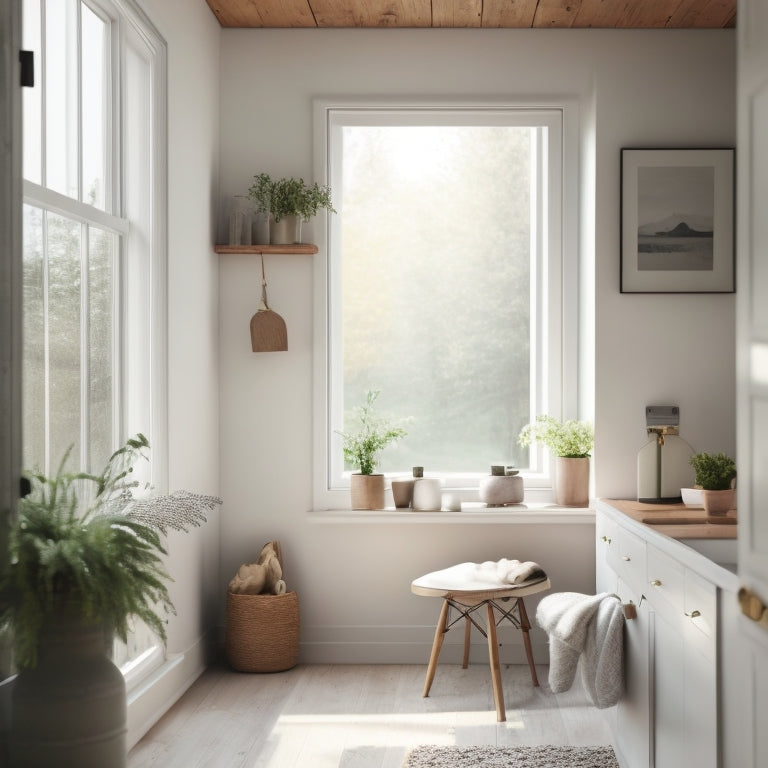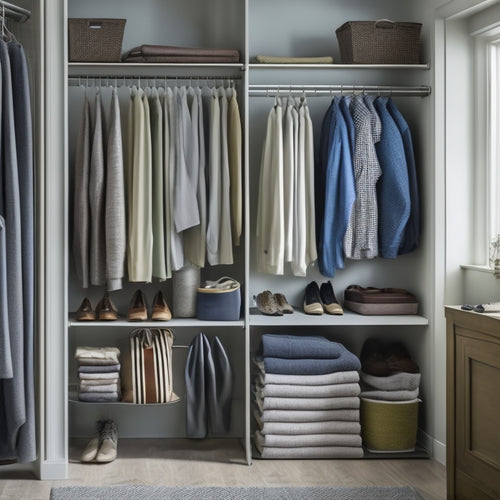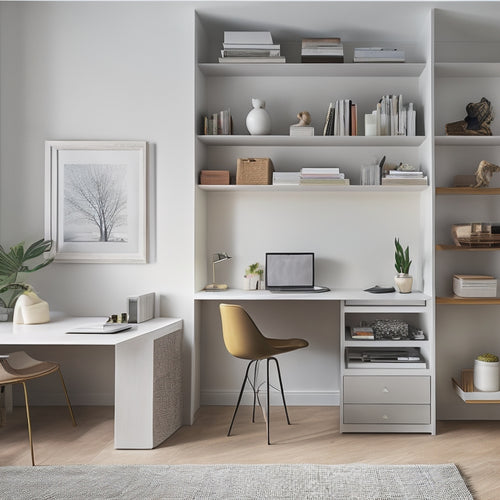
Mastering Clutter Control in Tiny Homes Fast
Share
You're about to discover the secret to a clutter-free tiny home, where every inch of space is optimized and every moment of your day is streamlined. Start by focusing on one area at a time, identifying clutter hotspots like entryways and kitchen countertops. Prioritize high-impact zones like kitchens and bathrooms, and simplify your daily routine to eliminate clutter buildup. Maximize storage capacity by utilizing vertical space, and establish a regular maintenance schedule to prevent clutter from creeping back in. By following these strategies, you'll be well on your way to mastering clutter control in your tiny home - and that's just the beginning.
Key Takeaways
• Start small by decluttering one area or category of items at a time to maintain momentum and focus.
• Prioritize high-impact areas like kitchens and bathrooms, which have the greatest impact on daily life.
• Streamline your daily routine by establishing consistent habits, setting boundaries, and dedicating time for tidying up.
• Maximize vertical storage space by using wall shelves, hooks, and storage racks to keep items off the floor.
• Establish a regular maintenance schedule to prevent clutter buildup and set aside time each week to maintain your space.
Start Small, Stay Focused
Start Small, Stay Focused
Begin with one area or category of items to declutter, rather than trying to tackle your entire tiny home at once, to maintain momentum and motivation. This approach helps you concentrate on a specific task, making it more manageable and less overwhelming. Identify clutter hotspots, such as your entryway or kitchen countertops, and start there. By focusing on one area, you'll be able to see the progress you're making, which will motivate you to continue.
Practice mindful decluttering by taking your time to sort through items, making intentional decisions about what to keep, donate, or discard. Don't worry about the rest of your tiny home; just focus on the task at hand.
As you declutter, you'll begin to notice patterns and habits that contribute to clutter accumulation. Use this insight to develop strategies for maintaining your newly organized space.
Prioritize High-Impact Areas
Identify the areas in your tiny home that have the greatest impact on your daily life, such as the kitchen or bathroom, and prioritize decluttering these spaces first to maximize your efforts and create a sense of accomplishment.
These Prime Zones are where you spend most of your time, and decluttering them will have the most significant impact on your daily routine. Focus on Busy Corners, such as countertops, shelves, and floors, where clutter tends to accumulate quickly.
| Area | Why It Matters |
|---|---|
| Kitchen | Meal prep and cooking are daily essentials |
| Bathroom | Morning and night routines rely on a clutter-free space |
| Entryway | First impressions and daily organization start here |
Streamline Your Daily Routine
By simplifying your daily routine, you can eliminate clutter hotspots and free up time for more important things. Start by examining your morning habits. What's the first thing you do when you wake up? Do you immediately check your phone, or do you take a few minutes to meditate or journal?
Establishing a consistent morning routine helps set the tone for the rest of the day. It also helps you prioritize what needs to be done, reducing the likelihood of clutter building up.
Next, establish daily boundaries. What're your non-negotiables? What tasks must you complete each day? By setting clear boundaries, you'll avoid overcommitting and leaving room for clutter to accumulate. For example, you might decide to dedicate 30 minutes each morning to tidying up or 15 minutes each evening to planning for the next day.
Utilize Vertical Storage Space
You can maximize your tiny home's storage capacity by leveraging its vertical space, where every inch counts. By utilizing wall shelves, you can store items like books, decorations, and kitchen utensils, keeping them off the floor and out of the way. Install shelves at varying heights to accommodate different-sized items and make the most of your walls.
Don't forget about the ceiling! Ceiling hooks can be used to hang bikes, pots and pans, or even a hammock, freeing up valuable floor space. You can also use overhead storage racks for luggage, camping gear, or out-of-season clothing.
When choosing wall shelves and ceiling hooks, consider the weight capacity and durability of the materials. Make sure they're sturdy enough to hold the items you plan to store.
With a little creativity, you can turn your tiny home's vertical space into a storage powerhouse. By doing so, you'll create a more organized, clutter-free living environment that's both functional and comfortable.
Create a Maintenance Schedule
Clutter control requires discipline, and establishing a regular maintenance schedule helps guarantee your tiny home stays organized and clutter-free. By setting aside time each week, you'll prevent clutter from building up and make cleaning easier. Create a schedule that suits your lifestyle and stick to it.
Here's a sample maintenance schedule to get you started:
| Task | Frequency | Duration |
| Daily Cleaning | Daily | 15 minutes |
| Laundry and Dishes | 2-3 times a week | 30 minutes |
| Seasonal Cleaning | Quarterly | 1-2 hours |
| Deep Cleaning | Monthly | 2-3 hours |
Task delegation is also key. Assign tasks to family members or roommates to share the responsibility and make it more manageable. Remember to review and adjust your schedule as needed to make sure it continues to work for you.
Frequently Asked Questions
How Do I Declutter Sentimental Items Without Feeling Guilty?
You're torn between keeping sentimental items and letting go, aren't you? Create a Memory Box for select items, then take photos of the rest. This way, you'll preserve the memories while breaking Emotional Ties to the physical objects.
Can I Still Have Hobbies in a Tiny Home With Limited Space?
You can still pursue hobbies in a tiny home with limited space. Consider Sarah, who turned her tiny kitchen into a photography studio using space savers like collapsible backdrops and creative compromises like schedules to guarantee shared use.
What if My Partner or Family Member Is a Clutterer?
When living with a clutterer, you'll need to set clear boundaries and establish compromise strategies to maintain a balanced space. Communicate your concerns, define shared goals, and create a system that works for both of you.
How Often Should I Review and Adjust My Clutter Control System?
You should review and adjust your clutter control system regularly, ideally during seasonal refreshes, to guarantee it remains effective. Schedule system audits every 2-3 months to maintain a clutter-free space that adapts to your changing needs.
What Are Some Eco-Friendly Ways to Dispose of Unwanted Items?
Did you know that 85% of unwanted items end up in landfills? You'll reduce waste by adopting eco-friendly disposal methods like Green Recycling and aiming for Zero Waste; consider donating, repurposing, or properly disposing of hazardous materials.
Related Posts
-

Why Double Rods Are Key to Small Closet Organization
By installing double rods, you can instantly double your storage capacity and open up a more organized, clutter-free ...
-

7 Essential Strategies for More Storage Space
Take back control of your space by implementing these 7 essential strategies for more storage space. Start by maximiz...

